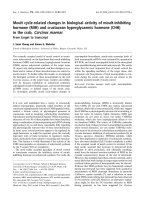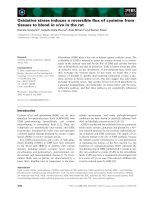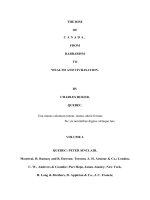Geisst wheels of fortune; the history of speculation from scandal to respectability (2002)
Bạn đang xem bản rút gọn của tài liệu. Xem và tải ngay bản đầy đủ của tài liệu tại đây (1.89 MB, 387 trang )
WHEELS
OF
FORTUNE
The History of
Speculation from
Scandal to
Respectability
Charles R. Geisst
John Wiley & Sons, Inc.
WHEELS
OF
FORTUNE
WHEELS
OF
FORTUNE
The History of
Speculation from
Scandal to
Respectability
Charles R. Geisst
John Wiley & Sons, Inc.
For Margaret and Meg
Copyright © 2002 by Charles R. Geisst. All rights reserved.
Published by John Wiley & Sons, Inc., Hoboken, New Jersey
Published simultaneously in Canada
No part of this publication may be reproduced, stored in a retrieval system, or
transmitted in any form or by any means, electronic, mechanical, photocopying,
recording, scanning, or otherwise, except as permitted under Section 107 or 108 of
the 1976 United States Copyright Act, without either the prior written permission
of the Publisher, or authorization through payment of the appropriate per-copy fee
to the Copyright Clearance Center, 222 Rosewood Drive, Danvers, MA 01923,
978-750-8400, fax 978-750-4470, or on the web at www.copyright.com. Requests to
the Publisher for permission should be addressed to the Permissions Department,
John Wiley & Sons, Inc., 111 River Street, Hoboken, NJ 07030, 201-748-6011, fax
201-748-6008, e-mail:
Limit of Liability/Disclaimer of Warranty: While the publisher and author have
used their best efforts in preparing this book, they make no representations or
warranties with respect to the accuracy or completeness of the contents of this book
and specifically disclaim any implied warranties of maerchantability or fitness for a
particular purpose. No warranty may be created or extended by sales representatives
or written sales materials. The advice and strategies contained herein may not be
suitable for your situation. You should consult with a professional where appropriate.
Neither the publisher nor author shall be liable for any loss of profit or any other
commercial damages, including but not limited to special, incidental, consequential,
or other damages.
For general information on our other products and services, or technical support,
please contact our Customer Care Department within the United States at 800-7622974, outside the United States at 317-572-3993 or fax 317-572-4002.
Wiley also publishes its books in a variety of electronic formats. Some content that
appears in print may not be available in electronic books.
ISBN: 0-471-21222-9
Printed in the United States of America.
10 9 8 7 6 5 4 3 2 1
Contents
Acknowledgments
vi
Introduction
vii
C 1
A Tale of the Pits
1
C 2
Futures and “Wild Jackasses”
49
C 3
The Great Bear Hunt
99
C 4
Expanding the Menu
143
C 5
Metals and Money
187
C 6
Chicago Follies
243
C 7
Rogues’ Gallery
297
Postscript
Bibliography
Index
353
355
360
v
Acknowledgments
J G J W &
Sons for overseeing the book from beginning to
end. Special thanks also to Ingram Pinn for designing the illustration opposite the title page depicting
Richard Nixon and Harold Wilson berating the infamous
gnomes of Zurich for speculating in the currency markets.
Without the gnomes, the financial futures markets would have
a much different history.
I
vi
Introduction
C teenth century, an old man was accosted by several
ruffians intent on robbing him. When they discovered that he was none other than Old Hutch, a legendary pit trader on the Chicago Board of Trade (CBOT),
they ran off, leaving him with his money and bragging rights
forever. Such was the power of commodities traders in the
nineteenth century. They and the exchanges where they plied
their trade were sources of legend and loathing.
Almost from the very beginning, the markets have been
called every imaginable name, from gambling dens to vital centers of commerce. They have been decried as having no economic value, yet praised as valuable marketing mechanisms.
After 150 years, their place in financial markets is vital and still
disputed. The commodities futures markets invite a wide
panoply of interpretation—from being the home of Satan
himself to the cathedrals of the messiahs of business, depending upon one’s point of view. Certainly, there has been no
shortage of opinion.
How these simple markets could evoke such deep emotions
O
vii
I
frames their history since their inception. The constant turmoil
surrounding futures trading since it began in St. Louis and
Chicago before the Civil War is a vital part of its history. Any
market relying on the open-outcry system of trading, where
traders communicate with each other by voice and hand signals
in a trading area, or pit, is bound to come under criticism. It
seems an unlikely place for serious economic functions to be performed. Critics contend that pit trading is for gamblers who stack
the odds in their favor. They are neither buying nor selling on
fundamentals but using collusion and manipulation to earn their
living. Nineteenth- and twentieth-century farmers used this argument without fail but never succeeded in convincing legislators to
alter or abolish futures trading. (They did come close, however.)
When the markets first developed, good intentions were
quickly swept away by the urge to trade. The original commodity contracts were nothing more than when-arrive contracts, meaning that a trader would pay another trader a
specific price established in the present for a future delivery.
There was no intention to trade them once they were created.
However, speculative elements soon took over as it became
clear that dynamic speculative markets were much more interesting—and profitable—than static forward markets. Contracts
began trading on a futures basis within a few years. Almost
immediately, cries of foul were heard, mostly from farmers
who realized that their cash prices were vacillating as a result.
More conservative elements in the business community also
decried open-outcry futures trading, believing that the commodities markets were becoming as bastardized as the stock
markets, which were already well-known for bear raids and
corners before the Civil War.
The history of the futures and derivatives markets is full of
misunderstandings and false assumptions. Over the years,
doubts have lingered, although the fundamentals of the markets are extremely simple and, in fact, based upon concepts that
viii
I
users and suppliers of commodities understand well. Simplicity
can be a mixed blessing, however; the mechanics may be
straightforward, but the applications may be highly sophisticated—even nightmarish. It is no wonder that nineteenthcentury farmers proclaimed ignorance of the markets, and it is
of even less wonder that financial experts were confused by the
problems encountered by Orange County, California, during
the early 1990s, when they tried to sort out the mess in its derivatives portfolio.
A futures contract is a contract to either buy or sell a specific amount of a commodity at a specific price for a distinguishable period of time. After the contract expires on a
standard date within a month, it becomes worthless, so it has a
useful but limited life for traders. Within its lifespan, the futures
price will fluctuate, depending upon the volatility of the commodity itself. Farmers, anticipating a crop, would sell contracts
short at a predetermined price and deliver their crop when it is
ready for the marketplace. Processors of the commodity would
similarly lock in a price by buying contracts and taking delivery.
Price uncertainty is removed in the process. Whatever happens
to prices after the trades is of no consequence, for the deals are
done at a specified price.
This simple selling (going short) or buying (going long) indicates that both parties engage in hedging, the fundamental reason that futures markets were established. During a contract’s
life, however, prices on the underlying commodity (cash prices)
will continue to vacillate. The earliest traders saw opportunity
in this vacillation. If they could buy or sell contracts again,
rather than take delivery, they could make a profit without
being bothered with the eventual physical delivery of the commodity itself. Buying or selling wheat futures for a profit was
certainly better than having to take delivery of the wheat and
then disposing of it in the cash market. Hence, futures trading
became popular almost immediately.
ix
I
When the urge to trade exploded in the markets, a whole
new world of market mechanics and chicanery was born.
Traders soon recognized that cash prices and futures prices
moved quickly in tandem and could be manipulated for personal gain. However, the tricks were not easy to execute. One of
the first market operations to be mounted was known as a corner. A trader attempted to corner the existing supply of a cash
commodity and then force the seller of the futures contract to
settle at the trader’s price to fulfill the seller’s obligation. By
buying more wheat contracts than actual wheat in supply,
prices would rise precipitously, often wiping out those who sold
the contracts. When the seller realizes that no wheat to deliver
can be found, that seller will be at the mercy of the longs who
exacted their financial revenge. The commodity will have been
cornered and the shorts will have been routed.
One of the first masters of this art of deception and hoarding was Benjamin Hutchinson, or Old Hutch, of Chicago. He
ruined dozens of floor traders during his years in the pits and
was damaged more than once himself. His reputation became
so fearsome that even premature reports of his death sent
wheat prices gyrating. Despite his harsh method of dealing
with fellow traders, Hutchinson constantly denied that wheat
corners were possible. Time and again he maintained that
there were simply too many amber waves of grain in the Midwest to assume that any mere mortal could actually corner the
market in wheat. Of course, that was usually a signal that a corner indeed was being mounted, and other traders would scurry
to join the operation or run for cover.
Futures trading became the signature of cowboy capitalism. The possibilities were endless, there were no boundaries,
and the rules of the game only seemed to be made up along the
way. The longs and the shorts stood opposite each other to have
a shoot-out of sorts, with the stronger, more dexterous surviving. Farmers objected to the futures exchanges because of these
x
I
myths and the amounts of money said to be made in corners
and bear raids, both exact opposites. When the corner and the
bear raid were combined in the same operation by a particularly clever pit trader, it became very difficult to tell what
exactly was happening. Normally, traders used the cash markets and the futures markets in tandem to mount a corner.
Bewildered farmers responded by asking state legislators to
shut the exchanges.
Oddly, the first attempts at closing the markets were the
best and only chance for farmers to accomplish that objective.
By the beginning of the twentieth century, the markets were
well established, and although suggestions that they be abolished occasionally were made, they were never seriously entertained. However, regulation at the federal level was slow in
coming. The first attempt to regulate the markets came in the
1920s, with legislation aimed at grain trading. In 1936, it was
expanded to all futures trading in the Commodity Exchange
Act, the futures markets’ equivalent of the Securities Exchange
Act of 1934. The exchanges barely noticed, though; they were
accustomed to having their own way for so many years that
they took little notice of the law, and attempts to enforce it were
rarely effective. Cowboy capitalism did not recognize a sheriff
without a loaded gun.
One of the central issues in the futures history is determining whether the sheriff has power to control the markets. In the
early 1970s, a major turning point in futures history came
when options on common stock were introduced along with
financial futures. Contracts on financial instruments opened
the markets to more participants than at any other time and
ensured their success. Unfortunately for the commodities act,
there was nothing in it about nonagricultural futures, and the
new markets grew rapidly with no effective regulator until the
Commodity Futures Trading Commission (CFTC) was created
in 1974.
xi
I
After the futures exchanges introduced financial futures,
the markets began to achieve the respectability that had been
lacking for decades. Now they were able to offer futures contracts on bonds, money market instruments, and stock index
futures, as well as options on common stock, which were also
developed in the early 1970s. The ironic part of this was that
these were contracts on underlying instruments traded in New
York rather than in Chicago. The cash market—the market for
the securities themselves—was found elsewhere, which, oddly,
gave the derivatives markets more legitimacy. The prices made
on the derivatives were based solely on the cash instruments
and investor demand. When the futures markets traded only
agricultural contracts, prices actually were trusted less, because
the cash prices were made under the same exchange roof. Having futures and cash prices made in the same locale often gave
rise to corners and bear raids. Separating the two gave the markets greater credibility.
Only when greater trust was achieved could the true function of the futures markets be realized. If all of the various
functions of the markets could be summarized in one term, it
would be price discovery. The true price of any commodity is the
cash price, assuming that it incorporates the factors that influence its futures prices. If the price of widgets is $1.00 cash and
97 cents for delivery in six months, then the futures price would
reflect market factors and conditions as well as the cost of storing the commodity for the length of the futures contract. Only
by comparing the cash and futures prices can one determine
whether the cash price is reflective of true value or an aberration in point of time.
The traditional futures markets became swamped by financial innovation during the 1980s and 1990s with the arrival of
the swaps market. When banks began making markets for
swapping interest rates, currencies, and commodities, the
derivatives markets became much more sophisticated and techxii
I
nical. Market risk also began to shift from exchange-related
products to these new contracts, which were designer over-thecounter (OTC) contracts between banks and corporate customers. The public had never heard of them until scandal
erupted—first in the London borough of Hammersmith and
Fulham, then in Orange County, California, and in Connecticut at a hedge fund called Long-Term Capital Management.
By the time the public and the press realized these scandals, the
financial system had already been groaning under the strains
imposed by cowboy traders who threw prudence and sensible
risk management to the wind.
Throughout their history, the derivatives markets have
often been associated with gambling. Much of the public
resentment against the futures markets in Chicago during the
nineteenth century was due to the activities of pit traders on
the CBOT, which were likened to casting enormous bets on the
prices of staples like wheat and corn. The markets were originally developed to serve as marketing mechanisms for agricultural products, but they soon took on an aura of a giant casino
where the croupiers dealt for themselves first. The characterization has lingered for years despite the best attempts of the
markets to project a sounder economic image, but terms and
techniques still seem to perpetuate the gambling analogy. A
familiar contemporary tool for evaluating bond risk under different economic scenarios is called Monte Carlo simulation, which
inadvertently gives the impression that financial markets are
nothing more than gambling casinos.
If any part of that analogy is true, the futures markets are
most responsible for conveying it. By the mid- to late 1980s, the
futures markets were keen to give the impression that they had
finally come of age and were as full-fledged as the securities
markets. Then, an FBI investigation into the practices of floor
traders was divulged in Chicago, providing the markets with
their once-a-decade dose of scandal and recriminations. The
xiii
I
fiasco revealed what has been known about the markets for
years: They appear to be inured to public opinion, claiming
that their functions are limited and difficult for outsiders to
fathom. In this respect, they are correct; trading in the pits has
befuddled more than one outside observer over the years.
In some cases, it is unfair to compare the futures markets
and their derivative brethren to the securities markets. Retail
investors do not flock to futures as they do to the stock market.
Their only real object of fascination is the options markets,
where calls and puts on stocks can be traded for a fraction of a
securities’ value. The OTC derivatives markets are purely
institutional, so they have a limited purpose for the average
investor. They remain hedging markets, where institutions and
corporations lay off risk by swapping or trading futures. The
inevitable scandals arise, as they do in every market, but in
hedging markets, they always somehow seem to be larger than
any other.
Being one step removed from the public does not mean that
the markets should not play by the same set of rules as the securities markets. Regulation of the financial markets proceeded at
a very slow pace in the first half of the twentieth century, and
regulation in commodities trading was the slowest of all. As
long as trading was confined to agricultural commodities, the
relative lack of regulation worked reasonably well. However,
when crises occurred, the lack of regulator muscle became
apparent. During the great bear raid of the early 1930s, regulators could not identify and prosecute a single perpetrator of
apparent price manipulation in grains because of vagaries in
existing laws. The one strong reaction against alleged price
manipulation came over 20 years later, when Congress actually
banned trading in onion futures in one of the more unusual
chapters in futures market history. For the most part, though,
attempts at regulating the markets were ad hoc until the CFTC
was created in 1974.
xiv
I
Even the markets’ equivalent of the Securities and Exchange Commission (SEC) had a hard time becoming accepted.
By the time the CFTC was created, the CBOT had been trading for over 125 years, and the exchange took a distinctly waitand-see attitude toward the new body. Part of the problem was
that the exchanges set high-flying goals for themselves, and the
trading methods they developed over the years were always
designed to ensure their survival. Being private exchanges, the
only way to expand their activities was to admit new members,
or locals, who would facilitate more activity on the trading
floors. They certainly knew more about pit trading than the
new regulatory commission, and they were not about to
enforce stringent rules concerning trading that were imposed
by those they considered amateurs.
Although the financial services industry in general is one of
the most regulated, the futures and derivatives markets are the
least regulated in the sector. Part of the problem in regulating
derivatives stems from their very nature. The contracts are
nothing more than trading positions that bind buyers and sellers. Most traders never take possession of the actual commodity involved, closing positions before they expire. As a result,
possession normally is not involved as it is in a securities transaction. A contract has a short life, regardless of whether it is an
option or a future. While the actual amount of money in a
derivatives transaction may exceed a securities transaction,
most professional traders profit or lose on the margins of a
deal’s price. They never hold a position long enough to suffer
serious losses on the position unless they deal in enormous
quantities. Moreover, if they are hedgers, the matter of winning or losing becomes academic as long as the hedge protects
an asset.
This short-term nature of derivatives trading gives the
entire industry a gambling casino environment. In the nineteenth century, farmers fulminated about wildly vacillating
xv
I
prices that could affect their crops. If farmers were not sophisticated, hedging would be impossible, and they were at the
mercy of traders’ prices. A century later, institutional customers complained about receiving suspect prices from the
Chicago exchanges. Traders routinely dealt for themselves
before dealing for customers through a practice called front running. As a result, they would profit regardless of the price executed for the customer.
The futures and derivatives markets have had more than
their share of scandal over the years. The fiascoes have given
the markets their cowboy nature. On balance, the scandals do
not outnumber those in other markets but always seem to be
more outlandish than others. The markets remain relatively
simple and somewhat cliquish, so when a trading scandal
erupts, it always seems to strengthen the hand of the markets’
critics, many of whom vividly remember the last scandal. However, during a scandal—especially of the kind that occurred in
the 1980s and the 1990s—more than one observer is left wondering how such relatively simple markets can create such a
monumental mess.
Although the markets have become sophisticated over the
years, some of their practices never seem to change materially.
The derivatives markets are unique, for they provide simple but
far-reaching hedging and speculative functions yet resist the
efforts of outsiders and regulators to fathom their secrets. They
remain the best examples of American market capitalism—
Social Darwinist environments, ingenuously proclaiming their
ability to provide clean, fair markets. Until the next scandal
breaks.
xvi
$$$$$$$
$ $ $ $ $ $
$$$$$$$
$ $ $ $ $ $
$$$$$$$
$ $ $ $ $ $
$$$$$$$
$ $ $ $ $ $
$$$$$$$
$ $ $ $ $ $
CHAPTER 1
A TALE OF THE PITS
C W A tudes toward life, liberty, and the pursuit of money.
The wrenching conflict tore at the very fiber of
American life and caused a rapid transformation
in views about accumulating wealth. Before the war, in what
later would seem like a halcyon period, savings and frugality
were heralded as traditional American virtues. During the
war, a wave of general speculation in gold and stocks swept
the country as the news of bloody battles filled the daily newspapers.
Oddly, the speculation came at the same time that Americans were also doing sensible financial planning. Before the
war, only about $5 million of life insurance was outstanding; by
1865, that amount jumped to about $700 million. Clearly, the
risk of war, as well as the trend toward increasing urbanization,
created a need to pass wealth to the next generation independent of the traditional method of willing land ownership. Americans had always been speculative, but before the war, their
speculation had been confined to lottery tickets and real estate
transactions. The war brought with it, however, an unprece-
T
2
A T P
dented speculative binge in commodities and gold. Bucket
shops sprang up around the country, fueling the fire even more.
These gambling parlors gave the average citizen the impression
that he or she could speculate in stocks and commodities like a
professional. The average person on the street was goaded by
stories of wealth and fortune created on the exchanges, and
professional traders, inspired by even grander notions, believed
that they could actually corner the entire supply of grain or
gold if they possessed an iron will and enough speculative
nerve. Clearly, the United States was on the verge of a great
revolution in its attitudes and pastimes.
Lotteries proliferated after the war, especially in the South,
where state legislatures were in desperate need of funds. Almost from the beginning, opponents of lotteries lobbied for
abolishing them, calling them immoral and capable of debauching the average citizen. The futures markets, however,
were on a slightly higher level. Their development during the
nineteenth century in the shadow of Wall Street was a mixed
blessing. These new markets had the dubious distinction of
being equated with the tradition of manipulation and greed for
which Wall Street was already well-known. Before the Civil
War, dealing with stocks and other intangibles was not considered a respectable vocation; the traders themselves were considered to be on the edge of proper society. When the futures
markets were developed, the public naturally looked askance at
them and the people who traded them; however, it knew that if
these new markets could succeed, their place in American economic life would be assured for generations to come.
Although the markets did succeed, their development was
subject to chance. Just as the price of wheat or corn was subject
to demand as affected by factors beyond one’s control—climate
fluctuations and insect infestations, for example—the futures
markets were subject to public skepticism, internal dissension,
and various external factors, all beyond their control. Unlike
3
W F
the stock markets, the futures markets never commanded the
widespread respect that the New York Stock Exchange (NYSE)
begrudgingly earned over the years. To Easterners, the markets
were the places where “hicks” traded agricultural commodities
basic to everyday life. Even in their own backyards, the markets
were seen as suspect places where predatory “city slicker” speculators took advantage of farmers who were not organized well
enough to fight back. There were actually attempts made during the nineteenth century to outlaw futures trading at both the
state and national level. The futures markets had crippling legislation passed against them, but they still managed to survive.
The introduction of futures markets in Chicago in the late
1840s certainly witnessed both the highs and lows of financial
life. From the beginning, the economic value of futures was
never seriously doubted, but those who traded them and their
motives were constantly questioned. The nineteenth-century
public vaguely understood what took place on the stock
exchanges but had little time for the prima donnas who were
their best known bulls and bears. Buying and selling railroad
shares was a legitimate activity to most observers, but when a
trader such as Jacob Little or Daniel Drew cornered stock by
buying all of the available supply or plunged it by selling it
short (forcing its price down, ruining the “longs” or buyers), the
overtly speculative nature of the market rose to the surface.
Adding insult to injury, the corners and the plungers both
seemed to do quite well financially, while the average investor
never seemed to get ahead of the game. The markets appeared
rigged in favor of the professional trader.
However shoddy the NYSE’s early reputation might have
been, the Chicago Board of Trade would suffer an even worse
opprobrium; it would endure legal challenges and hostile state
legislatures that made the stock exchanges’ problems pale by
comparison. The futures markets had another unpredictable
foe that did not trouble the stock exchanges, located mostly in
4
A T P
the East. In the Midwest, dealing in futures markets inspired
widespread cynicism even among believers because of that
region’s strong, ingrained Calvinistic work ethic. Profit gained
by trading intangibles was considered immoral; only real sweat
and labor should be rewarded. How could one claim to be
working when that person only shouted orders for buying and
selling wheat on an exchange? The one who should be
rewarded was the farmer whose sweat and toil brought the
wheat to market. There was something inherently wrong in
dealing with contracts rather than the real commodity itself.
That strong Midwestern ethic would dog the futures markets
for years.
The irrepressible force of westward expansion would push
futures markets into the spotlight. As the country continued to
grow, farms and cities began to develop west of the Mississippi
River. Chicago became the gateway to this vast area, almost
entirely devoted to agriculture. The railroads made Chicago a
central hub, and by the time the Civil War began, the city was
the main food supplier for the Union army and, along with St.
Louis, a major terminus. The agricultural industry developed
quickly, embracing farmers, millers, processors, warehousemen,
and the marketers. It was from this last group that the futures
markets developed. Trading grain futures on the exchanges was
seen as a step in the marketing process of getting grains into the
hands of consumers. Like their eastern stock exchange counterparts, futures traders claimed that their trading served a valid
economic function. Without it, the farmers would be left with
unsold crops and, even worse, potential economic ruin if prices
suddenly changed during a crop season.
Experience proved otherwise, at least as far as farmers were
concerned. Their crop prices were out of their control because
they were in the hands of a small group of professional traders
who manipulated prices on the futures exchanges for their own
benefit. Making matters worse were the railroads, which forced
5
W F
the farmers to pay high charges for getting their harvested
crops to the markets. The noble profession of farming was
being drained of its vitality by unscrupulous middlemen who
capitalized on farmers’ isolation and economic ignorance. The
whole economic process of farming needed to be returned to
its rural origins. City folk, schooled in the ways of speculation
and exploitation, had the farmers in a vulnerable position, a situation which only legislation could redress. The country was
moving westward too quickly, however, and the argument fell
on deaf ears. America was on the move, and the markets were
necessary for its economic development. The rural America so
fondly recalled by Alexis deTocqueville was rapidly giving way
to the new America of the railroad baron and the grain
plunger. But even progress could not halt the controversy surrounding the true nature of futures trading. When combined
with the stridency of the antimonopolist movement and the
reforms suggested by Populists and Grangers, the issue of
futures trading proved to be one of the more combustible of
the post–Civil War era.
FINE YOUNG CANNIBALS
As Chicago and other Midwest cities began to grow, they developed chambers of commerce and other local organizations to
cater to the business community. Locals gathered at these
places to dine, share contacts, conduct business, or simply
socialize. As early as 1836, in St. Louis a merchants’ exchange
was developed where all of the sundry commodities that traded
on the quay alongside the Mississippi River were organized
into a central marketplace. In 1856, Kansas City merchants
organized a board of trade to buy and sell commodities in an
orderly fashion. In Chicago, a similar sort of meeting place
known as the Chicago Board of Trade (CBOT) officially
opened in 1848 to less-than-resounding popularity. In the same
6









